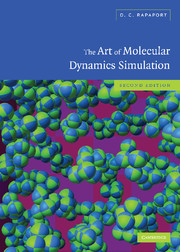Book contents
- Frontmatter
- Contents
- Preface to the first edition
- Preface to the second edition
- About the software
- 1 Introduction
- 2 Basic molecular dynamics
- 3 Simulating simple systems
- 4 Equilibrium properties of simple fluids
- 5 Dynamical properties of simple fluids
- 6 Alternative ensembles
- 7 Nonequilibrium dynamics
- 8 Rigid molecules
- 9 Flexible molecules
- 10 Geometrically constrained molecules
- 11 Internal coordinates
- 12 Many-body interactions
- 13 Long-range interactions
- 14 Step potentials
- 15 Time-dependent phenomena
- 16 Granular dynamics
- 17 Algorithms for supercomputers
- 18 More about software
- 19 The future
- Appendix
- References
- Function index
- Index
- Colophon
1 - Introduction
Published online by Cambridge University Press: 28 February 2011
- Frontmatter
- Contents
- Preface to the first edition
- Preface to the second edition
- About the software
- 1 Introduction
- 2 Basic molecular dynamics
- 3 Simulating simple systems
- 4 Equilibrium properties of simple fluids
- 5 Dynamical properties of simple fluids
- 6 Alternative ensembles
- 7 Nonequilibrium dynamics
- 8 Rigid molecules
- 9 Flexible molecules
- 10 Geometrically constrained molecules
- 11 Internal coordinates
- 12 Many-body interactions
- 13 Long-range interactions
- 14 Step potentials
- 15 Time-dependent phenomena
- 16 Granular dynamics
- 17 Algorithms for supercomputers
- 18 More about software
- 19 The future
- Appendix
- References
- Function index
- Index
- Colophon
Summary
Historical background
The origins of molecular dynamics – MD – are rooted in the atomism of antiquity. The ingredients, while of more recent vintage, are not exactly new. The theoretical underpinnings amount to little more than Newton's laws of motion. The significance of the solution to the many-body problem was appreciated by Laplace [del51]: ‘Given for one instant an intelligence which could comprehend all the forces by which nature is animated and the respective situation of the beings who compose it – an intelligence sufficiently vast to submit these data to analysis – it would embrace in the same formula the movements of the greatest bodies of the universe and those of the lightest atom; for it, nothing would be uncertain and the future, as the past, would be present to its eyes’. And the concept of the computer, without which there would be no MD, dates back at least as far as Babbage, even though the more spectacular hardware developments continue to this day. Thus MD is a methodology whose appearance was a foregone conclusion, and indeed not many years passed after digital computers first appeared before the first cautious MD steps were taken [ald57, gib60, rah64].
The N-body problem originated in the dynamics of the solar system, and the general problem turns out to be insoluble for three or more bodies. Once the atomic nature of matter became firmly established, quantum mechanics took charge of the microscopic world, and the situation became even more complicated because even the constituent particles seemed endowed with a rather ill-defined existence.
Information
- Type
- Chapter
- Information
- The Art of Molecular Dynamics Simulation , pp. 1 - 10Publisher: Cambridge University PressPrint publication year: 2004
Accessibility standard: Unknown
Why this information is here
This section outlines the accessibility features of this content - including support for screen readers, full keyboard navigation and high-contrast display options. This may not be relevant for you.Accessibility Information
- 2
- Cited by
